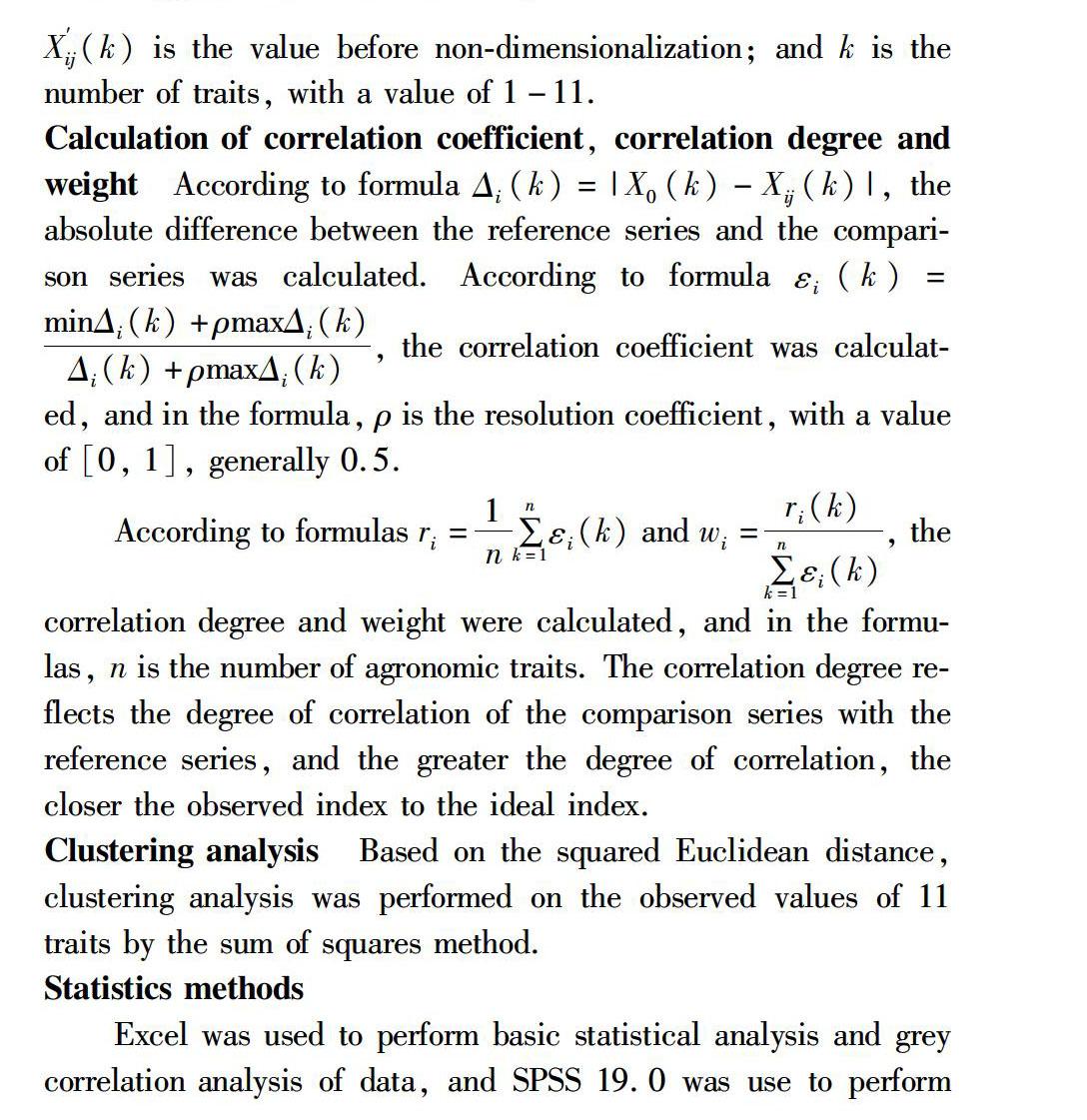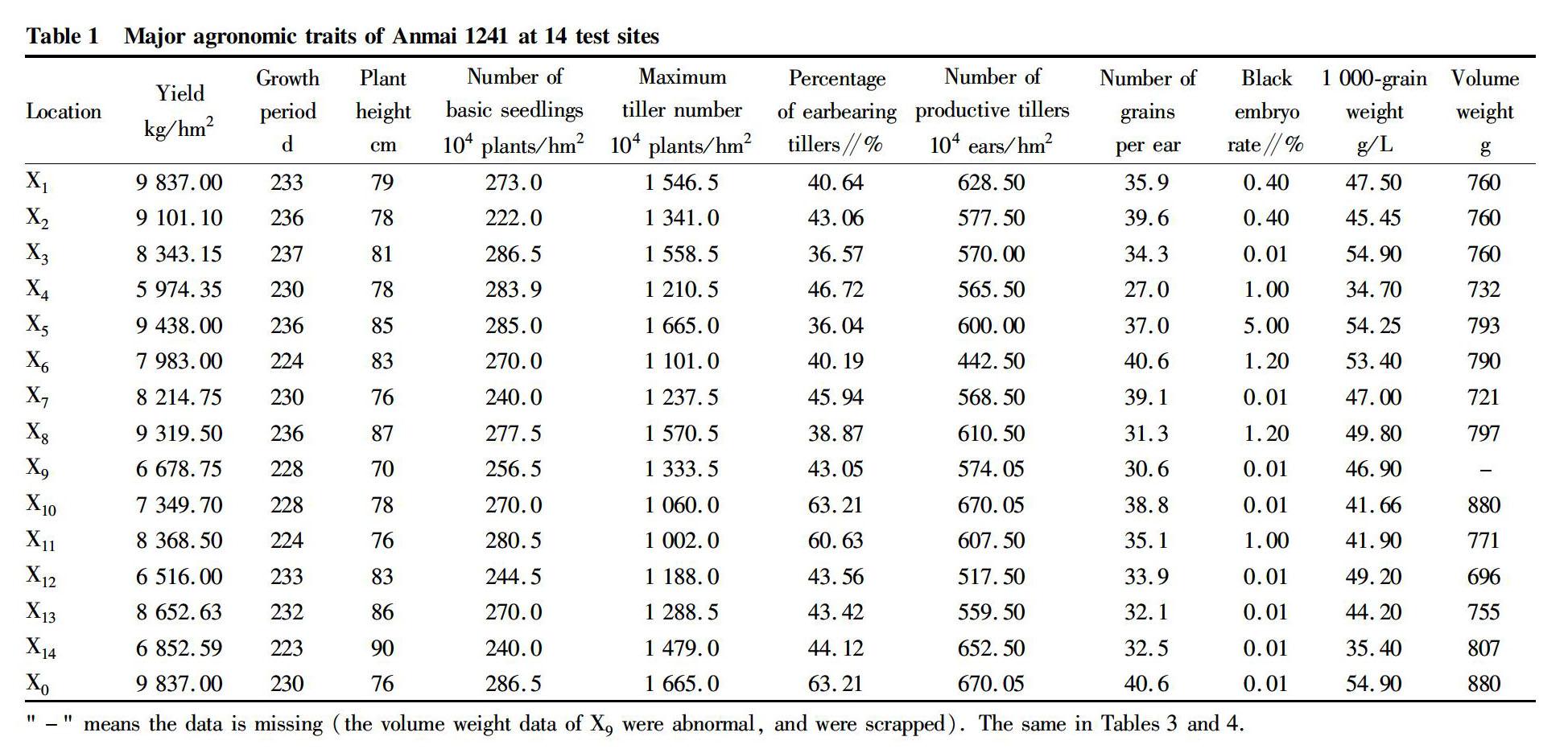Evaluation of Comprehensive Performance of Agronomic Traits of Anmai 1241 by Grey Correlation Analysis and Cluster Analysis Methods
2021-08-02YongHANZhiweiXUEChunlingYANG
Yong HAN Zhiwei XUE Chunling YANG



Abstract The agronomic traits of the new wheat variety Anmai 1241 were comprehensively evaluated, in order to provide comprehensive and objective theoretical basis for further improvement and production utilization of this variety. The winter water production test results of Anmai 1241 in 14 pilot sites of Henan Seed Management Station from 2016 to 2017 were summarized. The comprehensive performance of 11 agronomic traits of Anmai 1241 in different tests sites in Henan Province was evaluated by the grey correlation analysis and clustering analysis methods. The results showed that among the observed values of 11 traits, the variation coefficient, correlation degree and weight of black embryo rate were 181.64%, 0.667 9 and 0.105 1, respectively. The clustering analysis showed that the 11 traits could be divided into 3 groups. The first type of traits (yield, number of grains per ear and 1 000-grain weight) and the third group of traits (percentage of earbearing tillers, number of productive tillers and volume weight) belonged to the yield factor traits, and the sum of their weights was 0.524 2. Yield and its related factors played an important role in the variety evaluation of Anmai 1241, and the effect of black embryo on yield should be eliminated in variety improvement.
Key words Grey correlation analysis; Clustering analysis; Anmai 1241; Variety evaluation
Received: January 21, 2021 Accepted: March 23, 2021
Supported by China Wheat Research System (CARS-3).
Yong HAN (1978-), male, P. R. China, associate researcher, devoted to research about wheat genetic breeding and cultivation and farming.
*Corresponding author. E-mail: ayxm2004@163.com.
Wheat is the main food crop in China, and its grain yield is the result of the combined effects of multiple factors. It is of great significance to clarify the primary and secondary relationship of the impacts of various traits on the yield in breeding and cultivation[1]. The selection and breeding process of new crop varieties (lines) generally goes through many years of multi-site (environmental) experiments. When identifying new varieties (lines) of wheat, breeders often use analysis of variance and new multiple-range tests for yield analysis, and adopt the average method for the data analysis of other traits such as growth period, plant height, number of basic seedlings, maximum tiller number in spring, number of grains per ear, 1 000-grain weight, volume weight, etc. Although such method is conducive to the comparison of single traits between varieties (lines), the analysis results of various traits are independent and have no correlation with each other. How to evaluate the field performance of new wheat varieties (lines) more comprehensively and objectively, and comprehensively evaluate them, has become a common concern of agricultural science and technology workers.
Grey system theory is a system science theory pioneered by the famous scholar Professor Deng Julong. This method uses a fuzzy evaluation system to comprehensively evaluate multiple traits, and has become an important method for breeding materials and variety evaluation[2-3]. Crop breeding is a subsystem in the large agricultural system, which contains known and unknown information for breeders, and is a typical gray system. The combination of gray system theory and crop breeding can comprehensively consider a variety of factors, describe the extremely complex causal relationship in the process of crop breeding, and make optimal decisions for variety selection. The grey correlation analysis method is a method that can analyze and determine the degree of mutual influence between traits in the grey system. Liu et al.[4] first discussed the application of this method in the comprehensive evaluation of new crop varieties taking the data from regional trials of hybrid wheat as an example. At present, the grey correlation analysis method, as a comprehensive evaluation method for new crop varieties, has been widely used in the breeding of various crops such as wheat[5-6], maize[7-8], soybean[9], and peanut[10].
The current regional and production test sites are widely distributed. Moreover, the yield of wheat is the result of multiple traits, and the trait data are also very rich, so it is difficult to systematically analyze these data to make a comprehensive evaluation using appropriate methods. Comprehensive evaluation of new wheat varieties is actually to quantify the information contained in various trait factors with certain mathematical methods, so that scientific researchers have a more objective understanding of it. The grey correlation method is a method of quantitatively comparing the development situation of development and change systems[11], and clustering is a technique to find the internal structure among data by organizing the entire data into some similar groups. Based on the data information of 11 traits in the new wheat variety Anmai 1241 at 14 test sites from 2016 to 2017, the field performance of this variety was comprehensively evaluated using the grey theory and clustering analysis methods, aiming to provide a comprehensive and objective theoretical basis for the further improvement and production and utilization of this variety.
Materials and Methods
Experimental materials
The test wheat variety was Anmai 1241, and its growth period, plant height, number of basic seedlings, maximum tiller number, percentage of earbearing tillers, number of productive ears, number of grains per ear, black embryo rate, 1 000-grain weight, volume weight and yield data (Table 1) were all the summary of winter water production test results at 14 pilot sites in Henan Seed Management Station from 2016 to 2017. The 14 pilot sites were located in different cities in Henan Province, namely Henan Dehong Seed Industry (X1), Henan Huahui Seed Industry (X2), Henan Pingan Seed Industry (X3), Henan Seed Management Station (X4), Hebi Academy of Agricultural Sciences (X5), Huangfan District Farm (X6), Jiachuang Seed Industry (X7), Qianli Original Seed Farm in Luyi County (X8), Pingdingshan Academy of Agricultural Sciences (X9), Xinzheng Xuannong Crop Research Institute (X10), Changge Institute of Agricultural Sciences (X11), Zhengzhou Shengruiyuan (X12), Henan Fuwang Seed Industry (X13), and Zhumadian Academy of Agricultural Sciences (X14). X0 was the optimal value (reference value) of each trait.
Analytical method
Grey correlation analysis
Construction of reference series and comparison series
The various traits in different regions were regarded as the subsystems of the grey system, and the performance of each trait of Anmai 1241 at the 14 test points together constituted a grey system. First, the reference series (ideal series) was determined and designated as X0; and then, the comparison series was determined, and designated as X′ij when j traits were observed at i regions.
Dimensionless processing of data
The original data of each trait was subjected to dimensionless processing, so that each observation value was between 0 and 1. Among them, larger number of basic seedlings, maximum tiller number, percentage of earbearing tillers, number of productive ears, number of grains per ear, 1 000-grain weight and volume weight were better, that is to say, they belonged to positive indexes; the growth period and plant height should be moderate, and belonged to neutral indexes; and a smaller black embryo rate was better, and black embryo rate was a negative index. The non-dimensional calculation formulas for different types of indexes[11] were:
Positive indicator: Xij(k)=X′ij(x)/X0(k)
Negative indicator: Xij(k)=X0(k)/X′ij(k)
Neutral indicator: Xij(k)=X0(k)/〔X0(k)+|X0(k)-X′ij(k)|〕
In the formulas, Xij(k) is the value after non-dimensionalization; X′ij(k) is the value before non-dimensionalization; and k is the number of traits, with a value of 1-11.
Calculation of correlation coefficient, correlation degree and weight
According to formula Δi(k)=|X0(k)-Xij(k)|, the absolute difference between the reference series and the comparison series was calculated. According to formula εi(k)=minΔi(k)+ρmaxΔi(k)Δi(k)+ρmaxΔi(k), the correlation coefficient was calculated, and in the formula, ρ is the resolution coefficient, with a value of [0, 1], generally 0.5.
According to formulas ri=1n∑nk=1εi(k) and wi=ri(k)∑nk=1εi(k), the correlation degree and weight were calculated, and in the formulas, n is the number of agronomic traits. The correlation degree reflects the degree of correlation of the comparison series with the reference series, and the greater the degree of correlation, the closer the observed index to the ideal index.
Clustering analysis
Based on the squared Euclidean distance, clustering analysis was performed on the observed values of 11 traits by the sum of squares method.
Statistics methods
Excel was used to perform basic statistical analysis and grey correlation analysis of data, and SPSS 19.0 was use to perform clustering analysis of traits.
Results and Analysis
Descriptive statistical analysis of main agronomic traits of Anmai 1241
The coefficient of variation (CV) is a statistic that measures the degree of variation of an observed value. The degree of variation in each trait of wheat is a manifestation of its own genetic diversity. The CV in this study reflected the degree of stability of each trait in different locations. The statistical results (Table 2) showed that the CV values of 11 traits were in the range of 2.09%-181.64%, and the index values were in the order of growth period Grey correlation analysis of main agronomic traits of Anmai 1241 After non-dimensional processing of the original data of 11 traits (Table 3), the correlation coefficient (Table 4), correlation degree and weight (Table 5) of each trait index and the ideal index were calculated according to the formula. The results showed that the correlation degrees between the observed values of various traits and their optimal values (X0) of Anmai 1241 in the 14 pilot sites were in the range of 0.467 5-0.667 9, and except for the percentage of earbearing ears and volume density, the values of other trait index values were above 0.5. The weights of various traits were in the range of 0.073 6-0.105 1, with the highest value being 1.43 times the lowest value, and the index values were in the order of black embryo rate>number of basic seedlings>plant height>number of productive ears>number of grains per ear>1 000-grain weight>yield>maximum tiller number>growth period>volume density>percentage of earbearing tillers. Among the 11 trait observation indexes, the correlation degree and weight of black embryo rate ranked first, followed by the number of basic seedlings and plant height. The sum of the weights of yield and its three components accounted for 0.373 6 of the total weights of the 11 trait observation indexes, and yield and its related traits (yield, percentage of earbearing ears, number of productive ears, number of grains per ear, black embryo rate, 1 000-grain weight and volume weight) were 1.697 4 times of the sum of remaining 4 traits, indicating that grain yield and its related traits were in a dominant status in variety performance. Clustering analysis of main agronomic traits of Anmai 1241 The results of clustering analysis (Fig. 1) showed that 11 agronomic traits could be divided into 3 groups by the method of sum of squares of deviations in hierarchical clustering. Among them, the first type of traits included yield, grain number per ear and 1 000-grain weight, the second type of traits included growth period, plant height, number of basic seedlings, maximum tiller number and black embryo rate, and the third type of traits included percentage of earbearing tillers, number of productive ears and volume weight. The first type of traits and the third type of traits belonged to the related traits of grain yield; and the second type of traits belonged to the growth and morphological traits. Conclusions and Discussion The coefficient of variation represents the degree of probability dispersion. The smaller the coefficient of variation, the smaller the degree of variation (deviation), and the smaller the risk; otherwise, the greater the risk[12]. The results of this study showed that the variation coefficients of growth period, plant height, number of basic seedlings, volume weight and number of productive ears of Anmai 1241 were all lower than 10%, indicating that these 5 traits could be stably expressed in different regions of the 14 test sites in Henan Province, and were less affected by environmental conditions. Liang et al.[13] believe that the causes of wheat black embryo disease are complex, and environmental conditions, fungal infection and enzymatic browning will all lead to the formation of black embryos, but the three factors may have different effects on different varieties. The black embryo rate of Anmai 1241 varied from 0.01% to 5.00%, and the coefficient of variation was as high as 181.64%. It is still unclear whether the reason for the blackening of grains is pathological or physiological, and further exploration is needed. The evaluation of wheat varieties is actually to quantify the gray information reflected by each trait itself through certain mathematical means, so that people have a more objective understanding and accurate grasp of varieties as a whole, which not only has a scientific theory basis, but also is feasible in actual work[14-15]. In this study, the value of the reference series was determined based on the optimal value of the same variety at different test sites, and the reference value determined based on this could reflect the optimal value of Anmai 1241s trait performance in Henan Province. Weights are calculated based on the actual performance of different traits of varieties and based on the principle of the grey correlation system, which makes the evaluation results have a certain degree of reliability[16]. In this study, the 11 agronomic traits were divided into 3 groups by clustering analysis. According to the correlation degree and weight results of each trait, the correlation degree and weight of the first type of traits were calculated to be 1.700 0 and 0.278 4, respectively; the correlation degree and weight of the third type of traits were 3.024 1 and 0.475 8, respectively; and the correlation degree and weight of the third type of traits were 1.561 9 and 0.245 8, respectively. The first type of traits included yield, number of grains per ear, and 1 000-grain weight, and the third type of traits included percentage of earbearing tillers, number of productive ears and volume weight. Both types of traits were related to grain yield, indicating that yield and its related traits played a very important role in the comprehensive evaluation of Anmai 1241. In crop breeding, the specific relationship between various agronomic traits is difficult to be clarified and is not easy to be quantified. In grey correlation analysis, the grey correlation value reveals the importance of a comparison series of traits to the reference series of traits, and the position of the comparison series of traits among other comparison series of traits. The grey correlation analysis method is a method for dynamic quantitative comparison of development and change systems. Different time and ecological climate environment will both affect the analysis results of agronomic traits. Therefore, in the future research on Anmai 1241, it is necessary to add many years of multi-site test data to strengthen the systematic and in-depth research. There are many agronomic traits of wheat, only a part of them were involved in this study. In the follow-up work, some other trait observation indexes such as disease resistance, stress resistance and quality should be added to make the variety (line) evaluation more comprehensive. References [1] ZHOU XG, ZHANG ZB, XU P. Discussion on main breeding goals in wheat based on grey systems method[J]. System Sciemces and Comprehensive Studies in Agriculture, 2005(2): 81-84. (in Chinese) [2] DENG JL. Grey system and agriculture[J]. Journal of Shanxi Agricultural Sciences, 1985(5): 34-37. (in Chinese) [3] DENG JL. Summary of grey system[J]. World Science, 1983(7): 1-5. (in Chinese) [4] LIU LX, SUN QX, WANG SY. Preliminary study on the application of grey system theory in comprehensive evaluation of new crop varieties[J]. Scientia Agricultura Sinica, 1989(3): 22-27. (in Chinese) [5] YANG C, LI XD, ZHANG DQ, et al. Grey relational analysis and path analysis on wheat yield and its three key factors[J]. Journal of Henan Agricultural Sciences, 2016(10): 19-23. (in Chinese) [6] ZHAO Q, LIU ZY, LIU CL, et al. Grey correlative degree analysis on the new varieties of wheat[J]. Chinese Agricultural Science Bulletin, 2007(9): 259-262. (in Chinese) [7] WU LF. Grey relational analysis on main agronomic characters of maize[J]. Journal of Maize Sciences, 1997(1): 72-75. (in Chinese) [8] ZHANG J, ZHANG XR, YAN QJ, et al. Application of grey correlative degree analysis on comprehensive evaluation for new maize varieties[J]. Journal of Maize Sciences, 2006(5): 52-55. (in Chinese) [9] WANG RF. Application of grey relational analysis method in comprehensive evaluation of summer soybean[J]. Crops, 1999(5): 3-5. (in Chinese) [10] WANG Y, ZHANG XG, LI HM, et al. Relativity and gray correlation analysis major of the agronomic characters and yield of peanut [J]. Journal of Henan Agricultural University, 2014(6): 680-683, 705. (in Chinese) [11] ZAN K, ZHOU Q, ZHANG ZM, et al. Gray correlation analysis and DTOPSIS method for comprehensive agronomic performance analysis of new soybean varieties (lines) in Henan regional test [J]. Soybean Science, 2018(5): 664-671. (in Chinese) [12] WANG SQ, HU YG, SHE GJ, et al. Gray relational grade analysis of agronomical and physi-biochemical traits related to drought tolerance in wheat[J]. Scientia Agricultura Sinica, 2007(11): 2452-2459. (in Chinese) [13] LIANG XL, LI QY, NIU JS. Research advance in blacking mechanism of wheat grain with black point[J]. Journal of Henan Agricultural Sciences, 2016(8): 1-6. (in Chinese) [14] LI AG, SONG XX, WU CX. The grey correlation analysis between agronomic traits and yield in Triticum aestivum[J]. Crop Research, 2016(1): 18-21. (in Chinese) [15] HAN QX. Applying the grey relational analysis method to the multi-factorial evaluation of new wheat varieties (lines) in Shandong Province[J]. Chinese Agricultural Science Bulletin,2005(2): 312-314. (in Chinese) [16] BAI LF, LYU HZ, ZHU DZ, et al. Comprehensive evaluation method in crop breeding[J]. Agricultural Engineering, 2013(3): 112-119. (in Chinese)
杂志排行
农业生物技术(英文版)的其它文章
- Anti-inflammatory Activity and Mechanism of Total Flavonoids from the Phloem of Paulownia elongate S.Y. Hu in LPS-stimulated RAW264.7 Macrophages
- Comparative Genomic Analysis of Boron Transport Gene Family in Arabidopsis and Five Crops
- Effects of Different Water-saving Irrigation Methods on Fruit Quality and Yield of Snow Melon
- Field Control Effects and Crop Safety Assessment of Triazole Fungicides on Apple Rust
- Effects of Acetylacetone Solution Soaking on Agrobacterium-transformed Maize Seed Buds
- Effects of Meteorological Factors on Overwintering Ability, Yield and Quality of Forage Rape
